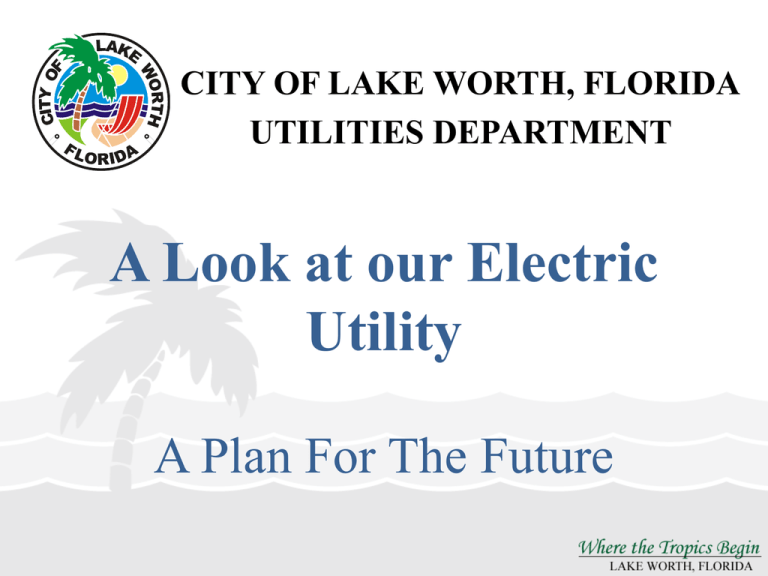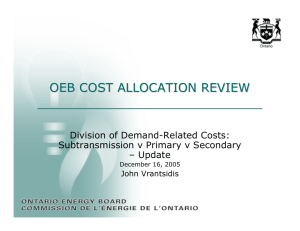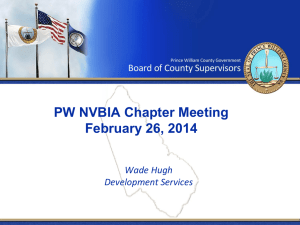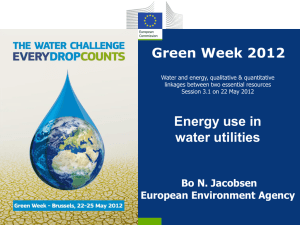click here for utility powerpoint
advertisement

CITY OF LAKE WORTH, FLORIDA UTILITIES DEPARTMENT A Look at our Electric Utility A Plan For The Future THREE FACITS OF PLANNING : •SUPPLY - is being addressed through the RFP process and is not included in this effort •TRANSMISSION - is included in the plan as well as addressed through the RFP process •DISTRIBUTION – The main focus of our presentation today. Commonly referred to as poles and wires Electric Utilities Long Range Plan WHERE DID WE START? • 40 sectors of service (or feeder as we engineers like to call them) have been identified for the Lake Worth Electric Utility territory • Each of these sectors serves approximately 200 thousand watts (2MW) of power demand • There are on average 650 customers per sector Electric Utilities Long Range Plan A LOOK FROM THE METER BACK TO THE SYSTEM: • Most of our meters are ‘dumb’ devices - they read the current that flows from the system to the house. • Current technology allows meters to do much more. • Smart meters can communicate with the customer’s house through internet and ‘talk’ to smart appliances as well as control devices. • They can also communicate with the utility by reading consumption, diagnosing electric problems, or providing service such as ‘pre-pay.’ • Our long range plan includes development and implementation of a communication backbone to support smart metering. Electric Utilities Long Range Plan OVERHEAD OR UNDERGROUND? • Currently, the service wires that connect to the customers’ houses are primarily overhead from rear lot lines or alleys. • The ultimate system would have all of these service wires underground from a system in the front or street side. • This plan will implement a combination of both, with all circuits East of Federal underground and a combination of underground and overhead West of Federal. Electric Utilities Long Range Plan • Deciding factors: – Cost has in the past been a major factor. However, cost differentials have diminished and in some cases underground distribution systems can be as cost effective as overhead systems. – Reliability or storm issues are major consideration for our coastal system. – Other elements of nature associated with a coastal construction, i.e. salt spray. – Line location (street or alley) and line type (distribution, transmission, or subtransmission) must also be considered. Electric Utilities Long Range Plan SO WHAT DO WE HAVE? • Differing types of construction and voltages 26kV distribution systems, 26kV subtransmission systems, and 4kV distribution systems. • Nine substations directly serving customer load. • Two substations serve the transmission and subtransmission system. • Tree growth into overhead lines, animal contacts, lightning, and material failure due to age. • Limited ability to sectionalize or ‘switch’ the system Electric Utilities Long Range Plan WHAT ARE OUR GOALS? • Standardization of construction designs and materials. • Standardization of substation protective devices (breakers and relays). • The ability to isolate and utilize adjacent ‘sectors’ to switch the distribution system for increased reliability. Electric Utilities Long Range Plan HOW DO WE GET THERE? • Do we utilize existing voltages? • Do we convert to a different distribution voltage? • Do we build a new subtransmission system? • There are NO WRONG answers. Electric Utilities Long Range Plan THE PLAN: • We are proposing to keep all of the existing substations to serve customer load – The sites already exist and the infrastructure is in place. – The ‘sectors’ are defined by these substations so we can utilize existing systems to a great extent. – Using multiple substations will minimize the customer exposure to system problems. – Using multiple substations will maximize the capability of the system flexibility. – Each substation will require less work (which translates to less money) when upgraded. – Using all existing substations will allow for a more systematic rebuild/conversion process. Electric Utilities Long Range Plan • We are proposing a 26.4kV subtransmission system. – A strong 26.4kV loop already exists throughout the service territory. – Most of the substations are built with 26.4kV equipment. – A 26.4kV subtransmission system will effectively serve the distribution system after reconfiguration. – Conversion to a higher voltage subtransmission system can be accomplished utilizing this same plan if load dictates however, economics do not justify a subtransmission conversion at this time or in the foreseeable future. Electric Utilities Long Range Plan • We are proposing a 13.2kV distribution system. – 13.2kV is an industry standard voltage. – Equipment and materials are readily available for this voltage. – Linemen are trained to safely work on a 13.2kV system. – Coordination of system protective devices (breakers, fuses, switches) is achievable. – A 13.2kV distribution system will handle the Lake Worth load for the foreseeable future in an efficient manner. – A 13.2kV distribution system coupled with a 26.4kV Subtransmission system is the most economical approach to manage system losses. – voltage support will be strong and system flexibility will be maximized. Electric Utilities Long Range Plan STAGES OF THE PLAN • Stage 1 --- installation of backbone communications for smart grid technology, system protection devices, and system operations control and data acquisition (SCADA). This stage is in planning and development and will ongoing for the next 3 years. • Stage 2 --- conversion of 4kV and 26.4kV distribution to standard 13.2kV distribution; unloading the existing distribution from the 26.4kV system. This stage will be ongoing for 10 years in conjunction with Stage 3. • Stage 3 --- development of a looped 26.4kV subtransmission system and development of a secured 138kV transmission system. This stage will be ongoing for 10 years in conjunction with Stage 2. Electric Utilities Long Range Plan PREVIOUSLY COMPLETED: • Eight 138kV transmission circuit breakers were purchased; six were installed in 2009/2010 • Thirteen 26kV subtransmission circuit breakers were purchased; 11 were installed in 2009/2010. • The remaining 4 circuit breakers will be installed at Main substation and Hypoluxo substation as defined by the Plan. Electric Utilities Long Range Plan PLAN SPECIFICS: Proposed costs include labor, transportation, material, and equipment. • Purchases include: – Twelve 26.4-13.2kV substation transformers estimated to be $375,000 each for a total cost of $4,500,000. – Ten 26kV circuit breakers estimated to be $50,000 each for a total cost of $500,000. • Distribution system (stage 2) rebuilds to support the 40 sectors will cost an estimated $14,750,000 over the next 10. • Total project cost over the 10 year period is $22,587,778. Electric Utilities Long Range Plan AGGRESSIVE TIMELINE APPROACH: • A 5 year conversion plan can be implemented with 25% of the system converted each year and the transmission and subtransmission systems reconfigured in year 5. • – Pros: The system will be state-of-the-art in a short time frame resulting in the best reliability. Parallel systems will be operated for the shortest time frame. Underground systems will replace overhead systems in designated areas resulting in aesthetics and operating improvements. – Cons: Costs will increase due to the need for contractors. Cash flow will be required in a shorter time period. Customers will need to accommodate the utility schedule rather than the utility working with the customers for system improvements. Electric Utilities Long Range Plan CONSERVATIVE TIMELINE APPROACH • A 10 year conversion plan will be implemented with 15% of the system converted each year and the subtransmission system rebuilt in conjunction with the distribution conversion. The transmission system will be reconfigured in year 5 independent of the conversion project. – Pros – The system will be rebuilt by in-house crews made up of existing linemen and new apprentices allowing for a training period for the new work force before attrition (retirements) takes the existing skilled work force knowledge base away. The ‘smart grid’ technology will be better defined and standards will be in place lessening the potential to invest in a system that may become obsolete. Costs will be spread over an additional five years, relieving the cash flow issue. Customers will have more time to work with the utility to best implement a plan of service. – Cons – The system will be operated at 3 voltage levels for a longer time frame. The subtransmission system will be utilized as a distribution system for a longer time period resulting in a potential reliability reduction. Electric Utilities Long Range Plan PERSONNEL • Currently there are 3 line crews composed of 9 linemen, 1 substation crew composed of 2 linemen, and 4 troublemen. • It is proposed to develop a lineman apprenticeship program and add 5 new line apprentices over the next 5 years. • After 5 years the attrition in the electric T&D department will place the staffing back to the current level. Electric Utilities Long Range Plan WHAT FACTORS DID WE CONSIDER? • Information from four previous distribution system studies. • Existing voltages and services currently serving our customers. • Optimization of existing systems and the ability to provide the best value in terms of initial cost, lifetime costs, reliability, operational flexibility, and aesthetics. • The need to provide detailed steps of initial construction and conversion processes. • The need for follow-up construction and system operations. Preparing to Serve our Community for the next 100 years









